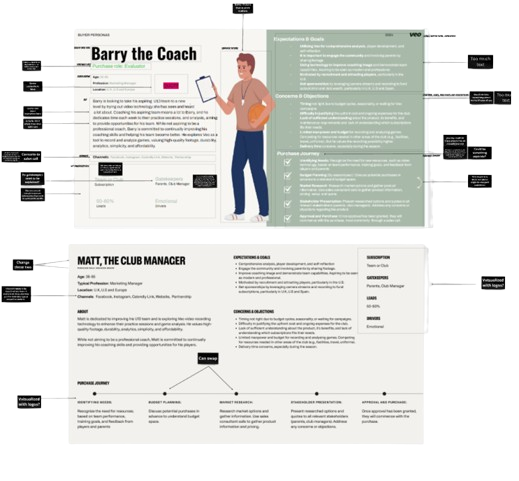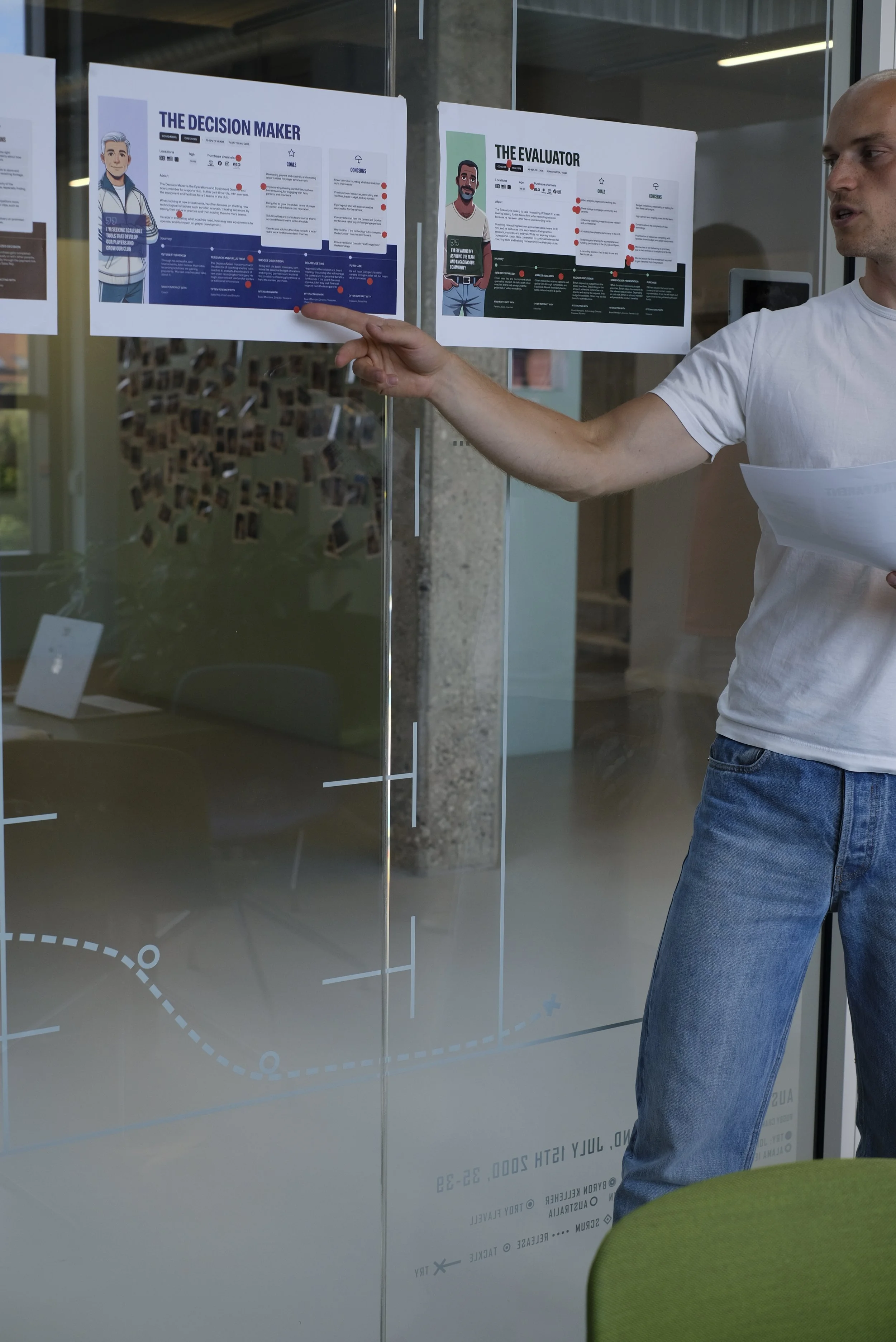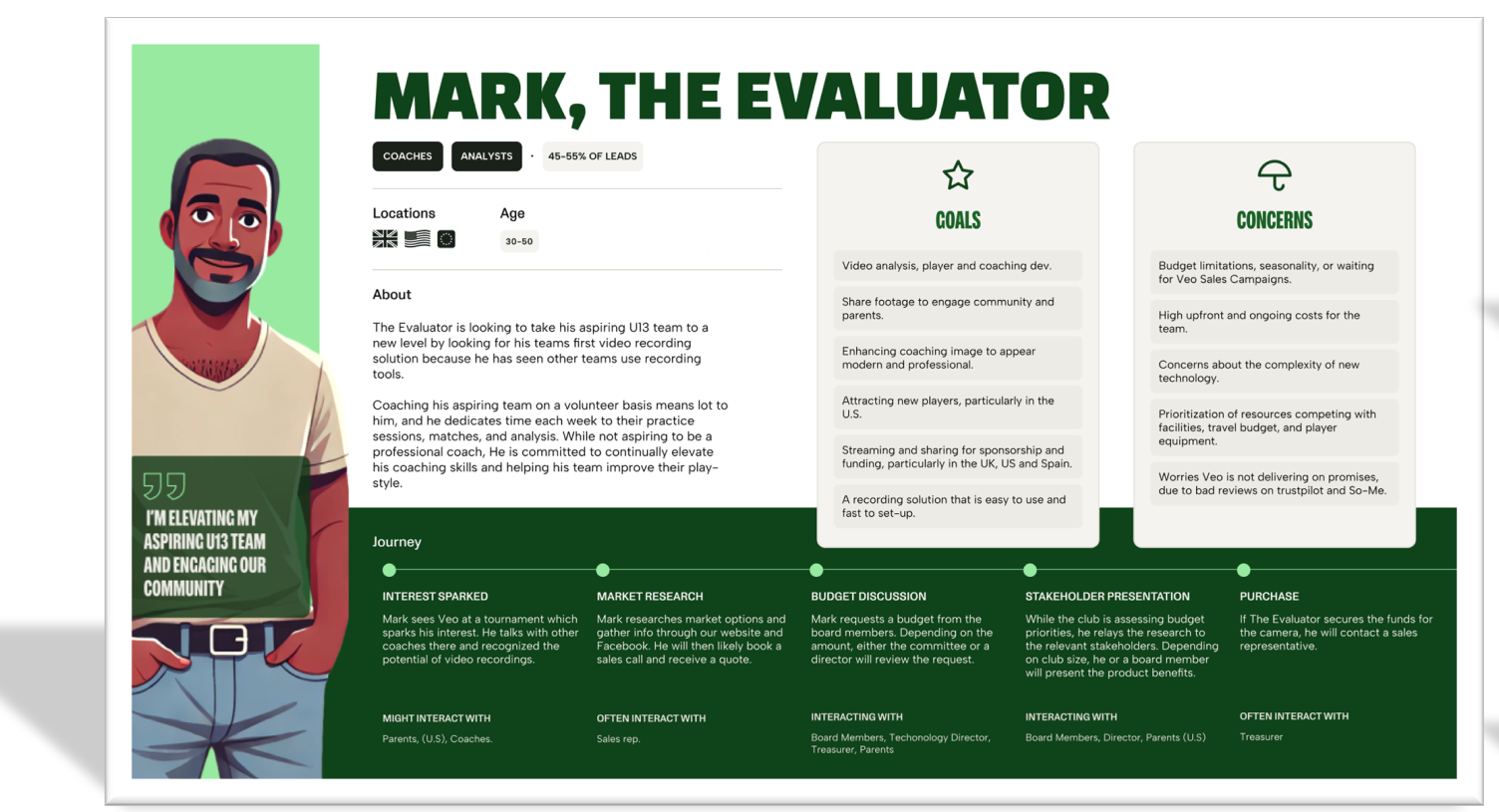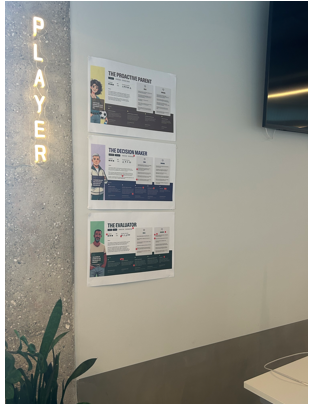Customer Personas Project Overview
Company: Veo Technologies
Role: User Experience Researcher
Team: Marketing, Product-led Acquisition, Product-led Monetization
Duration: 2024 Q2-Q3
Methods: Historical Qualitative Data, Event Data, Sales Data Analysis, Surveys, Interviews, Workshops
Tools: Amplitude, Figjam, Looker, Zoom, Hotjar, Dovetail, Active Campaign, Excel
Deliverables: Customer Personas
Veo Technologies
Veo is a technology company specializing in AI-powered video recording and analysis solutions, primarily for sports teams in various sports such as Football, Rugby, and Lacrosse.
Their main product is an automated camera system that records games and practices without the need for a camera operator, using AI to track the action on the field. Veo’s platform also includes tools for game analysis, allowing coaches, players, and analysts to review footage, create highlights, and assess performance.
Background
Methdology
Key Findings
Outcome
Reflections
1.0 - Background
Problem Space
Veo faced significant challenges that hindered the effectiveness of collaboration, strategy alignment, and fostering customer-centricity. The lack of shared terminology for both internal and external communication adds additional work and confusion. Additionally, the teams struggled to align marketing and monetization strategies with the actual needs and behaviors of our customers due to the absence of a robust customer framework. Recognizing these challenges, I, together with the Head of Growth in Marketing, saw an opportunity to initiate a customer persona project aimed at addressing these issues.
Business Objectives
Enhance our lead quality and efficiency by tailoring our marketing and product strategies to specific customer groups.
Guide our communication strategies and align cross-functional, internal, and external teams with common terminology and language.
Create a shared understanding of our key customers that fosters empathy and customer-centricity across the company.
Key Metrics
Sales Qualified Leads generated each month.
Organic self-service purchases.
2.0 - Research Goals
Investigate and understand key decision-makers in the purchase journey to learn their:
Needs.
Preferences.
Pain-points.
General Behavior.
Learnings will help us inform:
Product Development.
Marketing strategies.
Terminology within the company.
3.0 - Process & Methodology
Phase 1: Q2 April – Q2 April
Kick-off meeting
Alignment Workshop
Historical Qualitative Data (identifying patterns and contextual factors)
Marketing and Sales Data (providing a clear picture of different groups' demographics, purchase behaviors, and purchase preferences)
Phase 2: Q2 April – Q2 May
Internal Interviews (uncover insights from those closely involved with customers)
Customer Interviews (validate and discover pain points, motivations, and purchase journey)
Feedback Session
Phase 3: Q2 May – Q2 June
Implementation Workshop
3.1 - Phase 1: Priority and Alignment Workshop
The Head of Marketing Growth and I, along with the Product Managers and Product Designers from the Product-led Monetization and Product-led Acquisition teams, collaborated to identify the key questions and insights we need from our customers to successfully achieve our business objectives.
From that, we did a prioritization and assumption exercise to prioritize and align which questions/elements should be the main focus for the development of the Customer Personas.
3.2 - Phase 1: Historical Qualitative Data
Analyzing historical survey and interview data, I began to outline the key purchasers and influencers within our business.
I recognized that 4 key distinct groups of customers had various motivations and characteristics in their needs and goals for purchase.
These distinct groups could be segmented roughly in the relation they had to the football club they were in, which were:
Coaches
Parents
Directors
Analyst
3.3 - Phase 1: Marketing & Sales Data
Analyzed sales and marketing data to uncover behavioral insights and conversion pathways, highlighting effective marketing channels, such as Instagram, Facebook, and our website.
Identified that 90% of sales came through sales calls, with Coaches being the largest conversions group followed by Parents and Directors.
This data aligned with the historical data, confirming the significance of these roles in our ecosystem.
3.4 - Phase 2: Customer and Internal Interviews
Conducted internal expert interviews to highlight key traits defining various purchase-related customers and identified internal challenges affecting customer experiences.
Performed customer interviews that provided rich, qualitative data for detailed personas and captured authentic customer perspectives ensuring our findings were grounded in real experiences
This provided valuable insights into purchase behavior across club roles, highlighting analysts and coaches exhibiting similar purchasing patterns and goals.
I narrowed it down to three main customer profiles, defined by their purchase behavior, that could be clearly defined as the key decision-makers who corresponded with our marketing and sales conversion rates.
3.5 - Phase 2: Feedback Session
In a feedback session with the stakeholders, I presented the first Customer Persona iteration for a Coach and Club Manager.
Giving the stakeholders the opportunity to take ownership and provide valuable feedback on the first iteration in terms of comprehensibility and resonation of the data provided.
The session provided an opportunity to refine the stakeholder’s expectations and strategic goals, confirming that our approach and iteration, met those expectations.
Valuable changes were discussed, such as changing the behavior to being the primary driver instead of the club role.
3.6 - Phase 3: Implementation Workshop
In a feedback session with the stakeholders, I presented the first Customer Persona iteration for a Coach and Club Manager.
Giving the stakeholders the opportunity to take ownership and provide valuable feedback on the first iteration in terms of comprehensibility and resonation of the data provided.
The session provided an opportunity to refine the stakeholder’s expectations and strategic goals, confirming that our approach and iteration, met those expectations.
Valuable changes were discussed, such as changing the behavior to being the primary driver instead of the club role.
4.0 - Key Findings
Collaborative Decision-Making: Each persona interacts and talks with others during the purchase process, reflecting a team-oriented approach.
Sales Representatives: All three personas are likely to seek quotes, clarifications, feedback, or assistance in finalizing purchases.
Technology Adoption: There is a common fear that new technology may require excessive time or effort, along with skepticism about its promised benefits.
Integration: Technology adoption hinges on how easily it can be integrated into daily routines rather than just on features.
Sharing: Given their multiple responsibilities and volunteer capacity, each persona prioritizes solutions that enable easy sharing of footage and require minimal time and effort.
5.0 - Outcome; Customer Personas
5.1 - Outcome; Metrics and Behavioural Change
The integration of Customer Personas has positively impacted our workflow and decision-making processes. Key results observed over the following months include:
Increase in Sales Qualified Leads (SQLs):
Adoption of Customer Personas contributed to a higher conversion rate in our sales pipeline by 5%.
Improvements in email marketing performance:
Click-to-Open Rate (CTOR) rose by 14%.
Click-Through Rate (CTR) increased by 16%.
Enhanced support for product teams:
High levels of satisfaction and frequent usage of Customer Personas among product teams, enabling:
More informed hypothesis generation for projects. Reduced time requirements in the discovery phase.
Company-wide impact:
Presented Customer Personas to the entire company, establishing a common framework.
Adoption of shared terminology within teams, fostering clearer communication across departments.
5.2 - Outcome; Metrics and Behavioural Change
To streamline access to and navigation of our extensive Customer Persona data, I developed a customized GPT, "VeoPersonaGPT," and trained it exclusively on the validated data I had gathered. This ensured that VeoPersona only referenced accurate information, avoiding any non-validated inputs.
I shared VeoPersonaGPT with key stakeholders and the broader organization, enabling them to quickly search and retrieve specific insights about customer personas. The tool proved highly valuable, allowing stakeholders to ask comparative questions about persona similarities or use it for brainstorming and exploration.
However, I emphasized that VeoPersonaGPT should not replace the full, detailed personas or be relied upon for complex analysis. Instead, it serves as a quick, accessible way to navigate the incorporated data.
5.0 - Outcome
-

Customer Personas
It all begins with an idea. Maybe you want to launch a business. Maybe you want to turn a hobby into something more.
-

Metric and Behavioural Outcome
The integration of Customer Personas has positively impacted our workflow and decision-making processes. Key results observed over the following months include:
Increase in Sales Qualified Leads (SQLs):
Adoption of Customer Personas contributed to a higher conversion rate in our sales pipeline by 5%.
Improvements in email marketing performance:
Click-to-Open Rate (CTOR) rose by 14%.
Click-Through Rate (CTR) increased by 16%.
Enhanced support for product teams:
High levels of satisfaction and frequent usage of Customer Personas among product teams, enabling:
More informed hypothesis generation for projects. Reduced time requirements in the discovery phase.
Company-wide impact:
Presented Customer Personas to the entire company, establishing a common framework.
Adoption of shared terminology within teams, fostering clearer communication across departments.
-

VeoPersonaGPT
To streamline access to and navigation of our extensive Customer Persona data, I developed a customized GPT, "VeoPersonaGPT," and trained it exclusively on the validated data I had gathered. This ensured that VeoPersona only referenced accurate information, avoiding any non-validated inputs.
I shared VeoPersonaGPT with key stakeholders and the broader organization, enabling them to quickly search and retrieve specific insights about customer personas. The tool proved highly valuable, allowing stakeholders to ask comparative questions about persona similarities or use it for brainstorming and exploration.
However, I emphasized that VeoPersonaGPT should not replace the full, detailed personas or be relied upon for complex analysis. Instead, it serves as a quick, accessible way to navigate the incorporated data.
6.0 - Reflections
Navigating the differing objectives of Marketing, Product-Led Acquisition, and Monetization was a significant challenge. I learned that early alignment among departments is crucial for creating unified Customer Personas that effectively address diverse needs.
Limited data maturity hindered our ability to integrate qualitative and quantitative insights effectively. This experience taught me the importance of investing in robust data infrastructure to enhance the depth and comprehensiveness of future personas.
Presenting the persona information clearly and accessible proved challenging. I realized that thoughtful design is essential for ensuring that personas are easily interpretable and useful for cross-functional teams, highlighting the value of design in communication.
Determining which persona attributes to emphasize required careful judgment. This underscored the importance of focusing on high-impact elements to enhance the practicality and usability of personas in real-world applications.
learned the importance of dedicating time to understanding how each team can utilize Buyer Personas in their specific projects. Exploring the unique needs of different teams ensures that personas are practical tools that enhance decision-making and lead to greater organizational adoption.

















